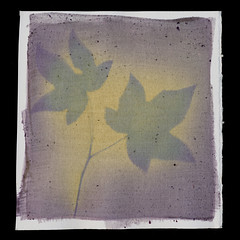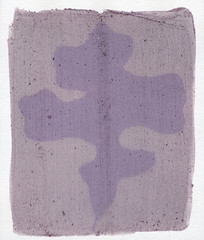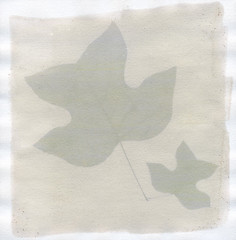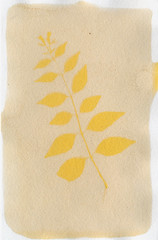 |
| First! |
My very first anthotype ever had a really interesting result. The yellow halo is a product of the moisture in the leaves leeching out into the paper and washing away some of the pigment. However, I've not been able to replicate this. I recently tried another batch of anthotypes using fresh blackberry juice, prepared the same way as the original batch, no halos.
So, I'm fairly sure there are two culprits:
The original anthotypes were exposed outside, in the direct heat of the scorching Southern sun.
They were not in picture frames, but smooshed between two plates of acrylic, allowing air flow.
 |
| No halo. |
I tried putting my picture frames outside, but no dice. I tried using two plates of acrylic inside, no dice. I think it needs both the airflow of an open frame and the blazing heat of the sun to produce the results I want. I will be trying this soon! I'm especially hopeful because another recent experiment with silk dyed in madder-root produced a moisture halo.
Oh, that's right, I never mentioned that test result. Why? It sucked. Maybe I picked a bad plant, because the leaf I used ended up virtually transparent by the end of the seven day exposure. Transparent leaf means there wasn't any light-blockage and the resulting image is almost invisible. Plus, the madder root stubbornly refuses to give me a good color. Also, it's transformed into a mess of green-brown-white fuzz.
I think I'm done with madder root for the time being, it hasn't been of any appreciable use yet. Maybe when I get around to my next project, where I buy raw wood and felt it down into my own hand-made cloth, then dye the cloth and make anthotypes on THAT... then I might use the madder root. Maybe. Probably not.



